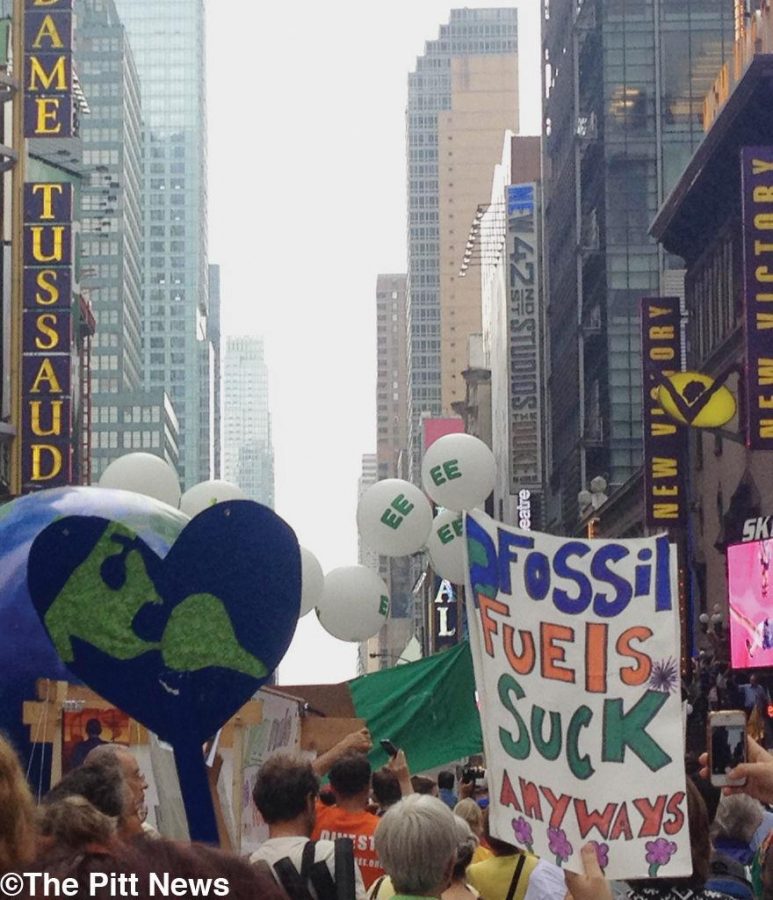Climate march reflects urgency, calls for immediate action
October 9, 2014
Three weeks ago, I walked in the People’s Climate March in New York City along with more than 300,000 individuals. Yet in the weeks following the march, I’ve monitored the news coverage of it and have been slightly disappointed.
There were many headlines during the days following the event boasting about its size and reach, and there were television stations replaying footage of the swarms of people flooding the Manhattan streets, but the buzz seemed to die within days.
Something great happened in New York City on Sept. 21, and we need to keep talking about it. More importantly, we need to understand why people marched that day.
The media coverage the march received was a little discouraging. Articles talked about Leonardo DiCaprio and Mark Ruffalo’s attendance, but glossed over the fact that the Secretary-General of the UN, Ban Ki-moon, was there as well.
Headlines also complained that the marchers left garbage piled on top of already filled trash cans but mentioned very little about the climate negotiations that took place the very next day.
Of course, the rally wasn’t without its problems. The city had been expecting around 100,000 protesters and was wholly unprepared for the 300,000 to 400,000 marchers who converged on the city in one weekend, many for a single day.
Had they known more people would show, they probably would’ve set up more trash receptacles and been better organized. The Pitt marchers spent two hours corralled on a sidewalk, not moving, because the streets couldn’t accommodate any more people.
In fact, barriers delineating the march path were removed toward the end in order to scatter people in different directions because it was simply too crowded.
The march also received criticism because it lacked unity and had no end goal. People representing myriad organizations came — from PETA, to the Sierra Club, to groups of vegans — all wanting to help the environment with a multitude of initiatives.
But rather than focusing on the faults with the march or on the handful of celebrities who attended, we must focus on the driving passion that inspired more than 300,000 individuals to leave their homes, carry signs and sing anthems in Manhattan.
The take-away from the march should be that, yes, there is an apparent problem and, more importantly, we can and need to do something about it.
The Earth is warming, and although there are still questions as to what exactly is driving this change in climate, it’s undeniable that we humans don’t treat the earth and environment kindly overall.
Reading articles about the environment is depressing. The Guardian recently released an article with research from the World Wildlife Fund that says the Earth has lost 50 percent of its wildlife in the past 40 years alone.
Another example of our destructive tendencies is Mt. Everest. In March 2014, Nepal declared that all climbers must descend with 18 pounds of trash because the mountain is so polluted. In fact, the path leading up to Everest is nicknamed “the toilet paper trail” because hikers do a poor job burying their waste and strands of toilet paper are left strewn about.
These are very physical reminders that we are having a large negative impact on the environment.
Tackling climate change by yourself is impossible, but small efforts — whether it be through recycling or using renewable energy — can help improve the environment and hopefully the climate.
Let’s do our part. Start small. Make sure all of the lights in your dorm or apartment are turned off when you leave. Unplug electronics when they’re not in use so they don’t suck phantom energy. Oakland has a biweekly recycling service, so place your recyclables in a blue bag and set them by the curb so that they can be properly disposed of. Try to eat less meat: Meat production, especially beef, requires tons of energy, so cutting down on your meat intake is an easy and effective way to curb energy costs.
Also, take the time to educate yourself about pertinent issues. If you know anyone who participated in the march or another activist, ask them what organizations they support, what issues they feel need to be addressed immediately and how you can get involved. Before you can be part of the solution, you have to understand what the problems are.
My roommate questioned the outcome of the march, saying it wouldn’t have much of an impact besides frustrating cab drivers for the day and clogging NYC streets. She didn’t understand how it could have an effect without a unified end goal.
But we have the power and responsibility to make the march lasting and effective. It’s easy to dismiss environmental issues as irrelevant and futuristic since we often don’t see its immediate effects. But as the statistics from the WWF and the mandate on Mt. Everest show, these are issues affecting the Earth right now.
By talking about the march and why people participated, hopefully we can help people understand that these are real, pertinent issues that need to be addressed and help spread the knowledge of how to participate in resolutions to environmental issues.
Instead of being part of the problem, we need to be part of the solution.
Email Channing at [email protected]








